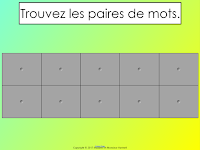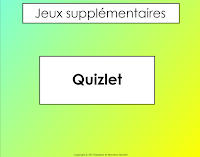Last year when I had a straight Grade 2
and a straight Grade 3 class, I decided to redo my word program. Together with
my wife, we put together our brains and our experience of teaching Primary
French Immersion and created high frequency word lists for Grade 1, Grade 2, and
Grade 3. Each list has 100 words that students in those grades should know. In
the past, I have always introduced five words a week, and have found that
number to work well, so we divided our list of 100 words into 20 weeks and made
Mots de la semaine – Words of the Week Program for Grade 2 and for Grade 3. I only introduce words on weeks when we
have a full five days with the students. My goal of this program is that my students learn to say the
words, identify the words, use the words in context, and to spell the words
with a reasonable degree of success.
What is my new word program?
(You can find our Mots de la semaine: 2e année –Gr 2 Words of the Week Program and our Mots de la semaine: 3e année –Gr 3 Words of the Week Program on TPT.
How we use the lesson: On Mondays, students write the 5
new words into their agendas with the translation in English in the morning
after announcements. They are encouraged to practice the words at home
throughout the week, either using their agenda, or using Quizlet, to prepare
for the collaborative quiz on Friday. Then we do an interactive Smart Notebook
lesson, that has five interactive activities for students to get familiar with
the words. I choose students to participate and help complete the different
activities. When I go through the intro lesson activities, I never speak any English; I don't say the English words at all. The English words are in some of the activities so that students develop an understanding of what these words mean, but I'm only speaking French during this time.
The first activity is very explicit - the students are just hearing the word and are trying to make a connection to the written word. At this point, the students still don't really know what the words mean; however, they may be starting to form a connection as they have copied them in their agenda. I purposefully write them on the board for them to copy into their agendas and leave them on the board while we do the intro lessons so that they may refer to them if needed. The next step is to solidify this connection so the next few activities focus on the connection between the French and English words. In this activity, students hear a word and must draw a line to the word of the week that they think they heard. After hearing all five words, we click on the words to reveal which recording matches that word.
The first activity is very explicit - the students are just hearing the word and are trying to make a connection to the written word. At this point, the students still don't really know what the words mean; however, they may be starting to form a connection as they have copied them in their agenda. I purposefully write them on the board for them to copy into their agendas and leave them on the board while we do the intro lessons so that they may refer to them if needed. The next step is to solidify this connection so the next few activities focus on the connection between the French and English words. In this activity, students hear a word and must draw a line to the word of the week that they think they heard. After hearing all five words, we click on the words to reveal which recording matches that word.
The second
activity is a game of matching the English words to the French words. There's no need to speak in English during this activity - the students can identify the French word that they think corresponds. If a student makes a mistake, it's the perfect opportunity to jump in and explain in French. For example, let's say a student chose the English word "student" and dragged it on top of the French word "parent". The English word will automatically bounce back since it is not correct. I might then say to the student, "Tu connais le mot que tu as choisi...Est-ce qu'il y a beaucoup de PARENTS dans la classe?" I may add, "Ou est-ce qu'il y a beaucoup d'élèves dans la classe?" I try to put the word in context in French for them.
The third activity is the memory game and when we play it, I'm really trying to solidify the connection between the English and the French. This is the only time that my students have the opportunity to say the English words. Again, I'm not using the English words. After a student comes up and chooses one word, I have them stop and I ask them in French which word they are searching for (I.e. If they chose an English word, do they know the French pair? If they chose a French word, do they know which English word goes with it?) I try to make this as purposeful as possible so students just aren't choosing randomly but are searching for the correct matching word, therefore developing their understanding of the connection between those two words.
The fourth activity is more of a verification and has the students hearing the word again in French (as well as seeing the word) and then selecting the English word that matches. This activity
shows students the word in French, they can tap to hear it, and then
must select which English word (of
three) corresponds to the given French word. For
an added bonus, students are working on their prepositional language, as the words « à gauche »,
« au milieu », and « à droite » are each above one of the English words. During this time, I integrate other language structures in French by having my students describe the location of the English word they are choosing with prepositions.
The fifth and final activity has students hearing the word in French and then coming up to the Smartboard and actually writing the word out. The fifth activity doesn't involve any English words at all. This activity requires the students to focus on the sound(s) in the words and how the word is written in French. I use this time to help assist my students with their proper letter formation. However, sometimes I switch it up and I write the word, but I write it with an error and have a student try to find my mistake and fix it. We always spell out the word in French as a class once we arrive at the correct spelling.
The last page is a link to the Quizlet website with flashcards and activities to practice the words.
How
we use Quizlet: Students are encouraged to practice
the words online with Quizlet. I always take time at the beginning of the year
to go over the website and show the students the different types of activities
that they can do and how to do them. There is a link to the words of the week
via the Smart Notebook lesson file, but I also have them linked to my blog. I
really like Quizlet because it allows the students to hear the words and
creates a number of activities for students to practice the words. Feel free to
share the Quizlet links with your students so that they can practice at home.
Other ways my students practice these words: During the week, not only are the students practicing the words at home with Quizlet, but the words are also incorporated in centers (building the mots de la semaine (in French only) in Minecraft (our word center)), and in games like Les mots fréquents. Les mots fréquents are flashcards that we've made, based on the same list of 100 high frequency grade level words that we use in our mots de la semaine program. We have four different games that we teach the students to play with Les mots fréquents (only French high frequency words are on these flashcards - no English). Aside from the 3 activities in the intro lesson, the English words are no longer being used.
How
we use the quiz: On Fridays, I hold a collaborative
quiz based on the words of the week. The quiz is composed of 10 questions and
the goal of the quiz is to encourage my students to select an answer and
justify their thinking in French. I do not keep track of how many answers each
student gets right or wrong, however, I do keep observations based on the
answers the students share with the class (their speaking and reasoning
abilities). We post the poster about the rules of the quiz and review them
before every quiz. Students are paired with a partner and discuss each question
with one another before voting on the answer. This really develops their active
listening and their reasoning skills. After the quiz is completed, I put the
words up on the word wall.
Each of the first five questions of the
quiz focuses on the correct spelling and identification of the
studied words. The next five questions are involve putting the French words in context in a French sentence. There are no translations during the quiz because by this time, the students understand the meaning of the words due to the pre-teaching that occurred during the intro lesson activities. Students are only speaking in French during the quiz as they select and justify their response. The sentence stems for their justifications are only written in French. Students must select the word of the week that makes the most sense. We post
the four posters of sentence stems for my students so they can have some
structure in discussing which answer they think is correct. Gradually the
students can be weaned off and use other ways of answering the questions as
well. Students state which answer they think is the correct one, and then
select from another poster, their reasoning (i.e. Je pense
que la réponse
est
A parce
que c’est
un mot de la semaine.)
Their partners can then either agree or disagree with their line of thinking,
but the partners must then share what their thinking is, and why they think
that. Each group chats at the same time, allowing one student in the pair to
talk at a time. As each group finishes talking, they give me a thumb’s up. Once
everyone is finished and giving me a thumb’s up, we go through all of the
options and when students think it is the right answer, they put their hand up.
I tap to reveal each response, and I help to explain why it is or is not
correct. Sometimes students will want to volunteer their justifications.


















